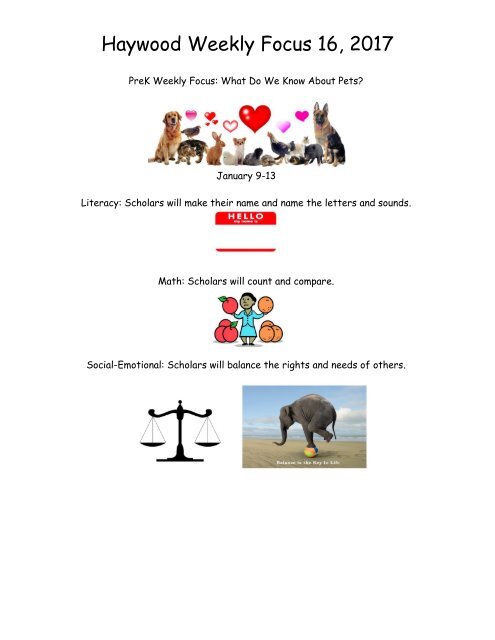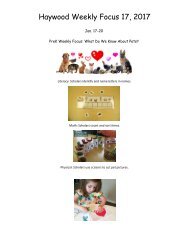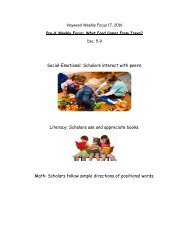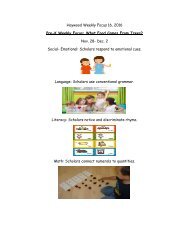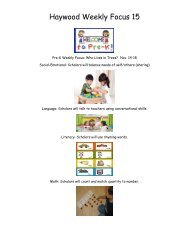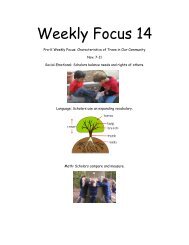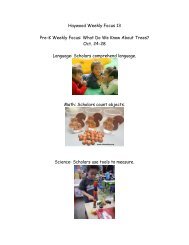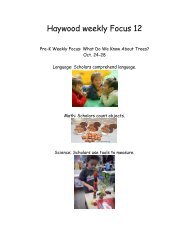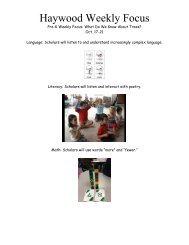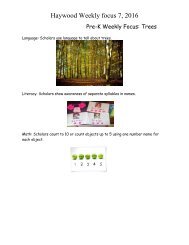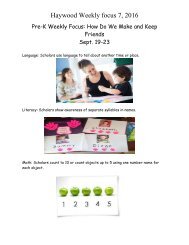Weekly Focus 16 2017
Create successful ePaper yourself
Turn your PDF publications into a flip-book with our unique Google optimized e-Paper software.
Haywood <strong>Weekly</strong> <strong>Focus</strong> <strong>16</strong>, <strong>2017</strong><br />
PreK <strong>Weekly</strong> <strong>Focus</strong>: What Do We Know About Pets?<br />
January 9-13<br />
Literacy: Scholars will make their name and name the letters and sounds.<br />
Math: Scholars will count and compare.<br />
Social-Emotional: Scholars will balance the rights and needs of others.
Haywood <strong>Weekly</strong> <strong>Focus</strong> <strong>16</strong>, <strong>2017</strong><br />
Subject Kindergarten <strong>Weekly</strong> <strong>Focus</strong> January 9-January 13<br />
ELA<br />
Scholars will, with prompting and support, describe the relationship between illustrations and the<br />
story in which they appear.<br />
Scholars will use a combination of drawing, dictating, and writing to compose<br />
informative/explanatory texts in which they name what they are writing about and supply some<br />
information about the topic.<br />
RI.K.6 Name the author and illustrator of a text and define the role of each.<br />
RI.K.5 Recognize common types of texts (story books, poems).<br />
RI.K.7 With prompting and support, describe the relationship between illustrations and the story<br />
in which they appear.<br />
W.K.2 Use a combination of drawing, dictating, and writing to compose informative/explanatory<br />
texts in which they name what they are writing about and supply some information about the<br />
topic.<br />
Activities for home: Practice reading sight words, letter names, and sounds. Practice writing and<br />
drawing about books read at home. READ, READ, READ!
Haywood <strong>Weekly</strong> <strong>Focus</strong> <strong>16</strong>, <strong>2017</strong>
Haywood <strong>Weekly</strong> <strong>Focus</strong> <strong>16</strong>, <strong>2017</strong><br />
Math Scholars will write numbers from 0-15, represent a number of objects with a written number 0-15.<br />
K.CC.A.3 Write numbers 0-15, represent a number of objects with a written numeral 0-15.<br />
K.CC.A.1 Count to 100 by ones and tens (Goal is up to 60).<br />
Social Studies<br />
Activities for home: Practice writing numbers 0-15 and counting numbers 0-60.<br />
Scholars will compare family traditions and customs among different cultures.<br />
K.3 Compare family traditions and customs among different cultures.<br />
K.2 Summarize people and places referenced in picture books, stories, and real life situations with<br />
supporting detail.<br />
Activities for home: Have conversations about your families traditions and customs. Have your<br />
child summarize places you go together (grocery trip, park, Walmart, etc.)
Haywood <strong>Weekly</strong> <strong>Focus</strong> <strong>16</strong>, <strong>2017</strong><br />
Language Arts:<br />
**Standard:<br />
RF.1.3c Know final _e and common<br />
long vowel team conventions for<br />
representing long vowel sounds.<br />
Objective:<br />
I can read and write long a words<br />
with a silent e.<br />
**Standard:<br />
RI1.3. Describe characters, settings,<br />
and major events in a story, using<br />
key details.<br />
Objectives:<br />
I can use text evidence and prior<br />
knowledge to draw conclusions<br />
about a story.<br />
I can infer and predict while reading<br />
a story to aid comprehension.<br />
**Standard:<br />
W 1.1 Write opinion pieces in which<br />
they introduce the topic or name<br />
the book they are writing about,<br />
state an opinion, supply a reason for<br />
the opinion, and provide some<br />
sense of closure.<br />
Objective:<br />
Journeys Lesson 14:<br />
Text: The Big Race<br />
Genre: Fantasy<br />
Strategy: Infer/Predict<br />
Skill: Conclusions/Cause and Effect<br />
Fluency: Expression<br />
Vocabulary: Shades of Meaning<br />
Writing: Opinion<br />
Grammar: Verbs and Time<br />
Word Study: came, make, brave, late,<br />
gave, shape<br />
High Frequency Words: four, over, two,<br />
five, starts, watch, into, three
Haywood <strong>Weekly</strong> <strong>Focus</strong> <strong>16</strong>, <strong>2017</strong><br />
I can write my opinion about a topic<br />
and give reasons for my opinion in<br />
complete sentences.<br />
Mathematics:<br />
Standard for the Week: 1.OA.C.6<br />
Add and subtract within 20, demonstrating fluency<br />
for addition and subtraction within 10. Use<br />
strategies such as counting on; making ten (e.g., 8<br />
+ 6 = 8 + 2 + 4 = 10 + 4 = 14); decomposing a<br />
number leading to a ten (e.g., 13 – 4 = 13 – 3 – 1 =<br />
10 – 1 = 9); using the relationship between addition<br />
and subtraction (e.g., knowing that 8 + 4 = 12, one<br />
knows 12 – 8 = 4); and creating equivalent but<br />
easier or known sums (e.g., adding 6 + 7 by<br />
creating the known equivalent 6 + 6 + 1 = 12 + 1 =<br />
13).<br />
*Monday 1/9/17<br />
Objective: I can use doubles to create<br />
equivalent, but easier sums.<br />
Go Math 3.4 Use Doubles to Add<br />
*Tuesday1/10/17<br />
Objective: I can use doubles plus one and<br />
doubles minus one as strategies to find<br />
sums within 20.<br />
Go Math 3.5 Doubles Plus One and<br />
Doubles Minus One<br />
*Wednesday 1/10/17<br />
Objective: I can use the strategies count<br />
on, doubles, doubles plus one, and<br />
doubles minus one to practice addition<br />
facts within 20.<br />
Go Math 3.6 Practice the Strategies<br />
*Thursday 1/11/17<br />
Objective: I can use a ten frame to add ten<br />
and an addend less than ten.<br />
Go Math 3.7 Add Ten and More<br />
*Friday 1/12/17 1.OA.C.6
Haywood <strong>Weekly</strong> <strong>Focus</strong> <strong>16</strong>, <strong>2017</strong><br />
Objective: I can use make ten as a strategy<br />
to find sums within 20.<br />
Go Math 3.8 Make a Ten to Add<br />
Science:<br />
GLE.0107.9.1<br />
**Standard: Classify objects<br />
according to their physical<br />
properties.<br />
GLE 0107.9.2<br />
**Standard: Distinguish between<br />
the properties and solids and<br />
liquids.<br />
Objective: I can classify and<br />
compare and contrast solids and<br />
liquids by using a Venn Diagram<br />
based on their size, shape, color,<br />
flow, ability to attract magnets, and<br />
appearance when mixed.
Haywood <strong>Weekly</strong> <strong>Focus</strong> <strong>16</strong>, <strong>2017</strong>
Haywood <strong>Weekly</strong> <strong>Focus</strong> <strong>16</strong>, <strong>2017</strong><br />
Social Studies:<br />
Unit 4: Our Country the United States<br />
Standards:<br />
Culture:<br />
1.2 Define multiculturalism as many different<br />
cultures living within a community, state, or<br />
nation.<br />
Geography:<br />
1.17 Identify the shapes of Tennessee and the<br />
United States on maps and globes.<br />
1.19 Locate Washington, D.C. and Nashville on<br />
a United States map.<br />
1.20 Distinguish the difference between a<br />
continent, mountain, river, lake, and ocean.<br />
1.22 Construct a map showing the Atlantic<br />
Ocean, Pacific Ocean, Washington D.C.,<br />
Memphis, Nashville, Knoxville, Chattanooga,<br />
Mississippi River, Cumberland River,<br />
Tennessee River, Great Smoky Mountains,<br />
Rocky Mountains, Center Hill Lake, Norris<br />
Lake, Reelfoot Lake, and Clingmans Dome.<br />
History:<br />
1.39 Use informational text to help describe the<br />
importance of celebrating these national holidays<br />
such as Martin Luther King Jr. Day.<br />
1.24 Summarize in their own words, that a<br />
map is a representation of a space, such as the<br />
classroom, the school, the neighborhood,<br />
town, city, state, country or world.
Haywood <strong>Weekly</strong> <strong>Focus</strong> <strong>16</strong>, <strong>2017</strong><br />
Second Grade <strong>Weekly</strong> <strong>Focus</strong><br />
1/9/17-1/13/17<br />
Essential Question: Why is it important to keep trying even if<br />
something is difficult to do?
Haywood <strong>Weekly</strong> <strong>Focus</strong> <strong>16</strong>, <strong>2017</strong><br />
Phonics<br />
Long I (i, igh, ie, y)<br />
Final syllable le<br />
Topic Standards I Can…<br />
RF.2.3a distinguish long and<br />
short vowels when reading onesyllable<br />
words.<br />
RF.2.3b know spelling-sound<br />
correspondences for vowel<br />
teams.<br />
RF.2.3c decode two-syllable<br />
words with long vowels.<br />
Strategies:<br />
Sight word review<br />
-Picture sorts<br />
-Making words<br />
-Sound boxes<br />
-Analogy chart<br />
-chunk big words<br />
-high frequency<br />
-Word cards<br />
-Decodable reader<br />
-Model fluency<br />
Connect sounds to writing and<br />
dictate sentences.<br />
Vocabulary<br />
I can acquire and use new vocabulary<br />
words.<br />
The crowd cheered for Jackie<br />
Robinson.
Haywood <strong>Weekly</strong> <strong>Focus</strong> <strong>16</strong>, <strong>2017</strong><br />
RL.2.2 Recount stories and<br />
determine their message,<br />
lesson, or moral.<br />
RL.2.10 Read and comprehend<br />
literature.<br />
I can identify the order of events<br />
in a story.<br />
Comprehension<br />
Main Idea and Details<br />
Target Skill: Sequence of Events<br />
I can retell what happened in a<br />
story by telling the order in which<br />
things happen.<br />
Formal and Informal Language<br />
Vizualization<br />
Supplemental Literature:<br />
My Brother Martin by Christine King<br />
Farris<br />
Teammates by Peter Golenbock<br />
Baseball Saved Us by Ken<br />
Monchizuki<br />
Moses: When Harriet Tubman Led Her<br />
People to Freedom by Carole Boston<br />
Weatherford<br />
Henry’s Freedom Box: A True Story<br />
From the Underground Railroad by<br />
Ellen Levine<br />
Sit In: How Four Stood Up by Sitting<br />
Down by Jane Addams<br />
The Drinking Gourd (Essential Lit-<br />
Dismukes)<br />
Biblioburro: A True Story from<br />
Columbia by Janette Winter
Haywood <strong>Weekly</strong> <strong>Focus</strong> <strong>16</strong>, <strong>2017</strong><br />
The Fantastic Undersea Life of<br />
Jacques Cousteau<br />
Martin’s Big Words by Doreen<br />
Rappaport<br />
Harvesting Hope: The Story of Ceasar<br />
Chavez by Kathleen Krull<br />
The Story of Ruby Bridges by Robert<br />
Coles<br />
The Librarian of Basra: A True Story<br />
from Iraq by Janette Winter<br />
Bringing the Rain to Kapiti Plain by<br />
Verna Aardema<br />
A Story A Story by Gail E. Haley
Haywood <strong>Weekly</strong> <strong>Focus</strong> <strong>16</strong>, <strong>2017</strong><br />
Strategies:<br />
-Five finger retell<br />
-Recall info. (BME)<br />
-Retell events in sequence<br />
-Discuss character’s feelings<br />
Grammar<br />
L.2.1 Demonstrate command of<br />
the conventions of standard<br />
English grammar and usage<br />
when writing or speaking.<br />
W.2.1 Write opinion pieces in<br />
which they introduce the topic<br />
I Can...<br />
determine if nouns are singular or<br />
plural to identify subject-verb<br />
agreement.
Haywood <strong>Weekly</strong> <strong>Focus</strong> <strong>16</strong>, <strong>2017</strong><br />
Writing:<br />
Opinion Writing<br />
or book they are writing about,<br />
state an opinion, supply reasons<br />
that support the opinion, using<br />
linking words (i.e because, and,<br />
also) to connect opinion and<br />
reasons, and provide a<br />
concluding statement or section.<br />
Math:<br />
2.MD.A.2- Measure the length of<br />
an object twice, using length<br />
units for two measurements…<br />
I can identify an opinion about the<br />
text or topic.<br />
I can produce and identify at least<br />
two supporting reasons for the<br />
opinion.
Haywood <strong>Weekly</strong> <strong>Focus</strong> <strong>16</strong>, <strong>2017</strong><br />
Social Studies:<br />
Unit 5: Famous Americans<br />
2.32<br />
Participate in shared research using<br />
biographies to interpret the<br />
significance of contributions made<br />
by people of the United States,<br />
recounting or describing key ideas<br />
and details from the texts. Teachers<br />
may choose any biographies.<br />
2.33<br />
With guidance and support from<br />
adults, use a variety of digital tools<br />
to produce and publish a writing<br />
piece in collaboration with peers on<br />
a famous American to describe how<br />
his or her accomplishments were<br />
significant.<br />
2.39<br />
Summarize the importance of<br />
commemorative months including<br />
Black History, Women’s History,<br />
Hispanic Heritage, and American<br />
Indian Heritage.<br />
<strong>Weekly</strong> Reader: Week <strong>16</strong><br />
I can research a Famous American in<br />
the United States and share their<br />
contributions with the class.<br />
Websites<br />
www.kidinfo.com<br />
www.brainpopjr.com<br />
kids.usa.gov/socialsocialstudiesforkids<br />
.com<br />
www.pebblego.com<br />
Resources:<br />
Journeys Anchor Text:<br />
Helen Keller (T314)
Haywood <strong>Weekly</strong> <strong>Focus</strong> <strong>16</strong>, <strong>2017</strong><br />
Informational Text:<br />
Jackie Robinson (T<strong>16</strong>4)<br />
Read Aloud: Doctor Salk’s Treasure<br />
(T214)<br />
Informational Text: Heroes Then and<br />
Now (T464)<br />
Read Aloud: Steve Jobs: Inventor<br />
(T410)
Haywood <strong>Weekly</strong> <strong>Focus</strong> <strong>16</strong>, <strong>2017</strong><br />
3 rd Grade <strong>Weekly</strong> <strong>Focus</strong> January 9-13, <strong>2017</strong><br />
Subject<br />
ELA<br />
<strong>Weekly</strong> Skills to Practice<br />
For the next 2 weeks, 3 rd grade ELA students will be focusing on MAKING<br />
CONNECTIONS and then being able to combine it with the skill of SYNTHESIZING in<br />
weeks to come. Those connections will first be broken down into students being<br />
able to apply it in 3 different ways: TEXT TO SELF, TEXT TO TEXT and TEXT TO<br />
WORLD. Next, student will be able to avoid making surface connections, and use<br />
higher order thinking skills to making deeper connections to a given text.<br />
Comprehension Skill/Strategy: Summarizing, Determining Importance, and Main Idea<br />
Grammar <strong>Focus</strong>: Using apostrophes in contraction words
Haywood <strong>Weekly</strong> <strong>Focus</strong> <strong>16</strong>, <strong>2017</strong><br />
Standards: SL.3.1.d<br />
Explain their own ideas and understanding in light of the discussion.<br />
SL.3.2<br />
Determine the main ideas and supporting details of a text read aloud or information<br />
presented in diverse media and formats, including visually, quantitatively, and<br />
orally.<br />
L.3.1<br />
Demonstrate command of the conventions of standard English grammar and usage<br />
when writing or speaking.<br />
Writing <strong>Focus</strong>:<br />
Standard: W.3.3-Write narratives to develop real or imagined experiences or events<br />
using effective technique, descriptive details, and clear event sequences.<br />
Additionally, students should be reading for 20 minutes each night. They should be<br />
recording what they are reading in their agenda nightly.
Haywood <strong>Weekly</strong> <strong>Focus</strong> <strong>16</strong>, <strong>2017</strong><br />
Additionally, students should be reading for 20<br />
minutes each night. They should be recording<br />
what they are reading in their agenda nightly.<br />
Social<br />
Studies<br />
Students will begin studying Europe. Student will be able to distinguish European<br />
culture, physical features and landforms from this country. Studies <strong>Weekly</strong> Weeks:<br />
<strong>16</strong> and 17<br />
Vocabulary <strong>Focus</strong>: (Social Studies)- Europe, culture, architecture, philosophy, Ukraine,<br />
Germany<br />
Standards: 3.39 Describe the diverse but unified nature of people within a continent<br />
or region, identifying the distinct contribution made by their culture including<br />
language, clothing, food, art, beliefs, customs, and music.
Haywood <strong>Weekly</strong> <strong>Focus</strong> <strong>16</strong>, <strong>2017</strong><br />
Science<br />
Standard: GLE 0307.Inq.4 Identify and interpret simple patterns of evidence to<br />
communicate the findings of multiple investigations Identify tools needed to<br />
investigate specific questions. Analyze and communicate findings from multiple<br />
investigations of similar phenomena to reach a conclusion.<br />
Objective: I can identify magnetic and nonmagnetic objects.<br />
Vocabulary:<br />
Magnet<br />
Attract<br />
Magnetic Poles<br />
Temporary Magnets<br />
Permanent Magnets<br />
Magnetism
Haywood <strong>Weekly</strong> <strong>Focus</strong> <strong>16</strong>, <strong>2017</strong><br />
Mat<br />
h<br />
Standards: 3.G.A.2 Partition shapes into parts with equal areas. Express the area of<br />
each part as a unit fraction of the whole. For example, partition a shape into 4<br />
parts with equal area, and describe the area of each part as 1/4 of the area of the<br />
shape.<br />
3.NF.A.1 Understand a fraction 1/b as the quantity formed by 1 part when a whole is<br />
partitioned into b equal parts; understand a fraction a/b as the quantity formed by a parts of<br />
size 1/b. (Grade 3 expectations in this domain are limited to fractions with denominators 2,<br />
3, 4, 6, and 8).<br />
Objectives:<br />
I can read, write, and model fractions that represent more than one part of a whole<br />
that is divided into equal parts.<br />
I can use a fractions to name one part of a whole that is<br />
divided into equal parts.<br />
I can identify equal parts of a whole.<br />
Academic<br />
Vocabulary<br />
Polygon<br />
Length<br />
Perimeter<br />
area<br />
Additionally: Students need to be<br />
multiplication facts daily. They have been<br />
multiplication cards for home practice.<br />
child what facts they are working on!<br />
practicing<br />
given<br />
Ask your<br />
Compute<br />
r<br />
Resource<br />
s<br />
BrainPop Jr.<br />
www.brainpopjr.com<br />
Username: eaglet<br />
Password: eaglet<br />
Flocabulary<br />
www.flocabulary.com<br />
Username: westmiddlestudent4<br />
Password: westmiddlestudent4<br />
IXL website<br />
Khan Academy website<br />
Learn Zillion website<br />
News<br />
You Can<br />
Use!<br />
Upcoming Dates to Remember:<br />
January 10th Report cards will be issued.<br />
January <strong>16</strong> th will be MLK Holiday = NO SCHOOL!
Haywood <strong>Weekly</strong> <strong>Focus</strong> <strong>16</strong>, <strong>2017</strong><br />
<br />
Haywood t-shirts are available for you to buy for $10 cash every Friday from 7:30 – 8:00 in<br />
the gym by the PTO!


